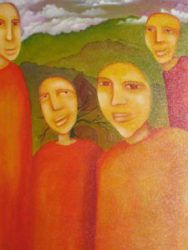Deaf
 Discussion of “d/D in “Deaf” is common in the Deaf community and amongst those who work with the Deaf community. Outside of the Deaf community, some people use small “d” (deaf) to refer to individuals who have attended mainstreamed public school and have not had the opportunity to interact within the Deaf community. Some use it as a medical label referring to audiological status of an individual while others use it to refer to an individual who does not have a Deaf cultural identity. The Canadian Cultural Society of the Deaf, the non-profit organization representing the cultural interests of the Canadian Deaf community, does not make these distinctions.[1] “Deaf” reflects that ASL and ASL Culture are the birthright of the individual by virtue of their having been born visually based or having become so in childhood, whether or not they have been exposed to ASL and the culture. “This is in keeping with how authors refer to individuals from other cultural minority groups such as Black or Jewish”.[2] Following their lead, we are using the upper case “D” (Deaf) for the remainder of the DATT based on their rationale. For further discussion of “Deaf” versus hard of hearing, hearing impaired and other terminology you can refer to the deafculturecentre.ca website, Frequently Asked Questions (Cripps and Small).[3]
Discussion of “d/D in “Deaf” is common in the Deaf community and amongst those who work with the Deaf community. Outside of the Deaf community, some people use small “d” (deaf) to refer to individuals who have attended mainstreamed public school and have not had the opportunity to interact within the Deaf community. Some use it as a medical label referring to audiological status of an individual while others use it to refer to an individual who does not have a Deaf cultural identity. The Canadian Cultural Society of the Deaf, the non-profit organization representing the cultural interests of the Canadian Deaf community, does not make these distinctions.[1] “Deaf” reflects that ASL and ASL Culture are the birthright of the individual by virtue of their having been born visually based or having become so in childhood, whether or not they have been exposed to ASL and the culture. “This is in keeping with how authors refer to individuals from other cultural minority groups such as Black or Jewish”.[2] Following their lead, we are using the upper case “D” (Deaf) for the remainder of the DATT based on their rationale. For further discussion of “Deaf” versus hard of hearing, hearing impaired and other terminology you can refer to the deafculturecentre.ca website, Frequently Asked Questions (Cripps and Small).[3]
Hello (your name sign!) 2004
Oil on canvas by Pamela Witcher
Courtesy of Anita Small
Empowerment
Empowerment goes beyond access and requires holistic systemic change. In the context of theatre, it ensures that Deaf performing artists are an integral part of theatre and that Deaf audiences not only have access to theatre but that they engage with theatre in which they see their own cultural experience as well as others. While access is palliative, empowerment is transformative and permeates the entire theatrical experience; while access provides selective opportunities to engage with parts of the theatrical environment, an empowering environment is generated through ongoing interactions. In this context, empowerment is the collaborative creation of power. In an empowering theatrical environment, Deaf performers’ identities are affirmed and extended in their ongoing interactions with fellow performers and audiences. Theatre amplifies “who they are”, rather than merely amplifying sound.[4]
It is important to note that in the process of the production of ULTRASOUND, and within the DATT itself, that in addition to Deaf culture, hearing culture and theatre culture, there are many nuances of intersectionalities of ethnicity, gender, sexuality, ability, etc. that are not specifically addressed. We acknowledge that these intersectionalities create their own questions, discoveries and richness of experiences, but are not necessarily included in the DATT. We hope in the future, that more in-depth conversations and explorations can be added to this toolkit.
[1] Cripps, J.S. and Small, A. The Lower Case “d” or Upper Case “D”. Retrieved from http://www.deafculturecentre.ca/Public/Default.aspx?I=299&n=The+Lower+Case+”d”+or+Upper+Case+”D”
[2] Small, A. Cripps, J.S. and Cote, J. (2012). Cultural Space and Self/ identity Development Among Deaf Youth. Monograph I. Toronto, Ontario: Canadian Cultural Society of the Deaf and Knowledge Network for Applied Education Research, pg 46. http://www.deafculturecentre.ca/Common/ResearchN/Items/9_Mono_FINAL_4.pdf
[3] Cripps, J.S. and Small, A. Hearing Impaired? Hearing Handicapped? Hard Of Hearing? Deaf? What’s In A Label? Everything! Retrieved from http://www.deafculturecentre.ca/Public/Default.aspx?I=295&n=Hearing+Impaired%3f
[4] Small, A. & Cripps, J. (2009). Attitude Planning: Constructing A Language Planning Framework Toward Empowerment In Deaf Education. In: Reference Guide: Barrier Free Education, Toronto, Ontario: The Canadian Hearing Society.

